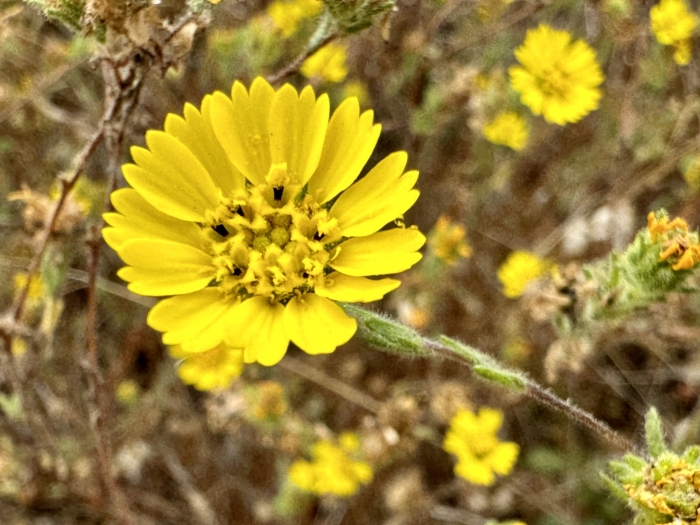Coastal Tarweed
(Deinandra corymbosa)
Coastal Tarweed (Deinandra corymbosa)
/
/

Henrik Kibak
CC BY 4.0
Image By:
Henrik Kibak
Recorded By:
Copyright:
CC BY 4.0
Copyright Notice:
Photo by: Henrik Kibak | License Type: CC BY 4.0 | License URL: http://creativecommons.org/licenses/by/4.0/ | Rights Holder: Henrik Kibak | Publisher: iNaturalist | Date Created: 2023-09-15T23:00:31Z |






















Estimated Native Range
Summary
Deinandra corymbosa, commonly known as Coastal Tarweed, is an annual herb native to California, specifically the coastal prairies and grasslands of the Coast Ranges from Humboldt County to Santa Barbara County. It can reach up to 40 inches in height and is characterized by its sticky stems and foliage. Coastal Tarweed blooms from late spring through fall, producing numerous yellow flower heads that are composed of both disc and ray florets, which are attractive to a variety of pollinators.
Coastal Tarweed is valued for its adaptability to different environmental conditions and its ability to thrive in coastal regions as well as isolated inland areas. It is often used in native plant gardens and restoration projects due to its ease of maintenance and role in supporting local wildlife. This plant prefers full sun exposure and can tolerate a range of soil types, from sandy to clay, provided they are well-drained. While it is drought-tolerant once established, it benefits from occasional watering during prolonged dry periods. Coastal Tarweed is not commonly associated with serious diseases or pests, but it can become weedy if not managed properly, potentially outcompeting other plants in the garden.CC BY-SA 4.0
Coastal Tarweed is valued for its adaptability to different environmental conditions and its ability to thrive in coastal regions as well as isolated inland areas. It is often used in native plant gardens and restoration projects due to its ease of maintenance and role in supporting local wildlife. This plant prefers full sun exposure and can tolerate a range of soil types, from sandy to clay, provided they are well-drained. While it is drought-tolerant once established, it benefits from occasional watering during prolonged dry periods. Coastal Tarweed is not commonly associated with serious diseases or pests, but it can become weedy if not managed properly, potentially outcompeting other plants in the garden.CC BY-SA 4.0
Plant Description
- Plant Type: Herb
- Height: 1-3 feet
- Width: 1-2 feet
- Growth Rate: Moderate
- Flower Color: Brown, Yellow
- Flowering Season: Spring, Summer, Fall
- Leaf Retention: Deciduous
Growth Requirements
- Sun: Full Sun
- Water: Low, Medium
- Drainage: Medium
Common Uses
Bee Garden, Drought Tolerant, Low Maintenance
Natural Habitat
Native to the coastal prairies and grasslands of the Coast Ranges in California
Other Names
Common Names: Coastal Tarweed, Flat-topped Tarweed, Corymbosa Coast Tarweed
Scientific Names: , Deinandra corymbosa, Deinandra corymbosa subsp. corymbosa, Deinandra corymbosa subsp. macrocephala, Hartmannia corymbosa, Hemizonia angustifolia, Hemizonia angustifolia subsp. angustifolia, Hemizonia angustifolia subsp. macrocephala, Hemizonia angustifolia subsp. macrocephala, Hemizonia angustifolia var. angustifolia
GBIF Accepted Name: